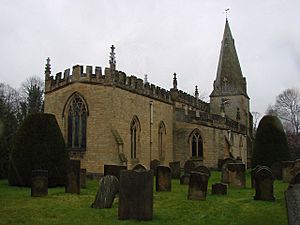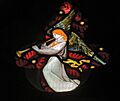St Anne's Church, Baslow facts for kids
Quick facts for kids St. Anne’s Church, Baslow |
|
|---|---|

St. Anne’s Church, Baslow
|
|
| 53°14′49.65″N 01°37′26.25″W / 53.2471250°N 1.6239583°W | |
| Country | England |
| Denomination | Church of England |
| Churchmanship | Broad Church |
| Architecture | |
| Heritage designation | Grade II* listed |
| Administration | |
| Parish | Baslow |
| Deanery | Bakewell and Eyam |
| Archdeaconry | Chesterfield |
| Diocese | Diocese of Derby |
St. Anne’s Church in Baslow is a historic Church of England building. It is located in the village of Baslow, England. This church is very old and has a special heritage listing called Grade II* listed. This means it is an important building with a lot of history.
Contents
History of St. Anne's Church
Early Beginnings
St. Anne's Church is really old. It was first built in the 1200s, which is the thirteenth century. Imagine how many people have visited this church over hundreds of years!
Major Updates in the 1800s
The church has been updated and repaired many times. A big restoration happened in 1852. A famous architect named Sir Joseph Paxton helped with the plans. He was known for designing the Crystal Palace.
During this time, many changes were made:
- A new chancel, which is the part of the church near the altar, was added.
- Old plaster and a gallery were removed to make the space feel more open.
- The organ was improved and moved to a new spot.
- Beautiful stained glass windows were put in.
- New pews, which are the long benches where people sit, were installed. They were made in a gothic style.
- A new marble pulpit, where the priest gives sermons, was added.
- The floor in the chancel was paved with special Minton tiles.
- A new room for the clergy, called a vestry, was built.
- A new way to get to the bell tower from outside was created.
- Central heating was put in to keep everyone warm.
The church reopened in December 1853 after these big changes.
More Renovations in the Late 1800s
The church was restored again in 1894. It was cleaned, and new stained glass windows by Hardman of Birmingham were installed. The choir stalls, where the choir sits, were replaced with new ones made of oak wood. A reredos, which is a decorated screen behind the altar, was also added. The chancel floor was updated with mosaic tiles. John D Webster was the architect for this work.
Twentieth Century Changes
The chancel of the church was rebuilt again in 1911. This shows how churches are often cared for and updated over many years.
Tower Clock Details
A Special Gift
On the east side of the church tower, there is a round clock face. It has the letters V I C T O R I A 1 8 9 7 written on it. This clock was a gift from Dr. Edward Mason Wrench. He gave it to the church to celebrate Queen Victoria's Diamond Jubilee in 1897. A jubilee is a special celebration of a long reign.
Church Connections
St. Anne's Church is part of a joint parish. This means it shares a priest and works closely with other churches nearby. These churches are:
Churchyard Features
War Grave Memorial
The churchyard, which is the burial ground around the church, has a special grave. It is the war grave of an Army Chaplain from World War I. This grave helps us remember those who served.
Interesting Fact: The Dog Whipper
A Unique Piece of History
St. Anne's Church is known for something quite unusual. It still has a whip that was once used by the parish dog whipper. In the past, a dog whipper was a person whose job was to remove stray dogs from the church during services!
Church Organ Information
The First Organ
The church has a pipe organ. The first organ was put in back in 1849 by a company called Davis. It had nine different sounds, called stops. Mr. Trimnel, who worked at Chesterfield Parish Church, played it for the first time on September 23, 1849.
Newer Organs and Repairs
This first organ was replaced in 1865 with a new one by Brindley & Foster. George Henry Smith from Sheffield Parish Church played it for its opening on December 5, 1865. This organ was later repaired by Brindley and Foster in 1895. More restoration work was done by other companies, Conacher and Co, and Chalmers and Hyde. You can find more details about the organ on the National Pipe Organ Register.
Church Bells
Ancient Bells
The church tower holds six bells. The oldest bell is very old, dating all the way back to 1520! It was made by Ralph I Heathcote.
Images for kids






